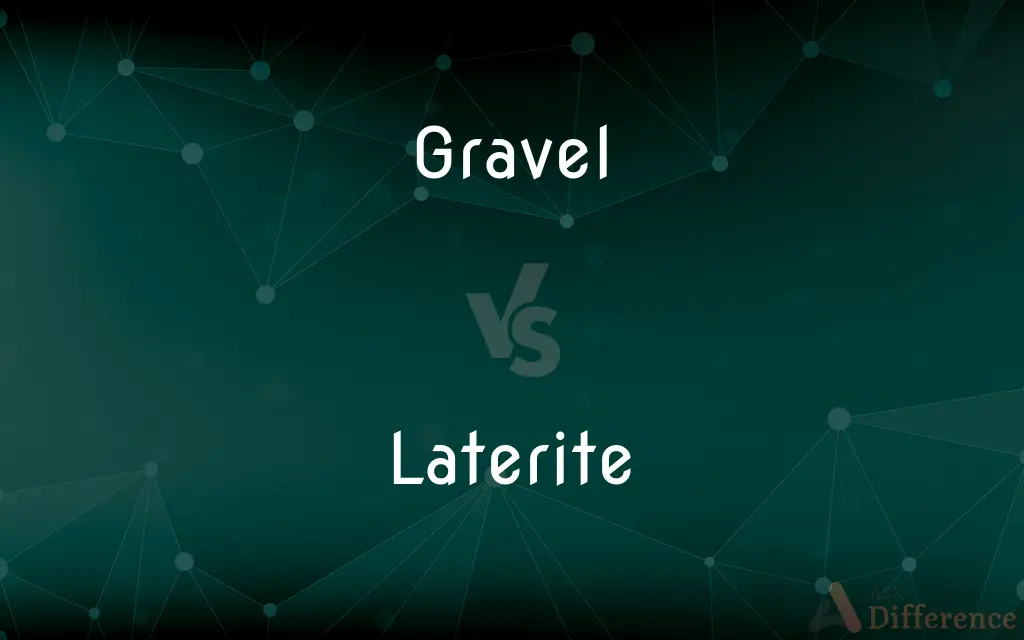Gravel vs. Laterite — What's the Difference?
By Tayyaba Rehman & Urooj Arif — Updated on March 31, 2024
Gravel is a versatile, coarse aggregate used in construction and landscaping, known for its rock composition, whereas laterite is a soil and rock type rich in iron and aluminum, formed in hot and wet tropical area, used primarily in building construction.

Difference Between Gravel and Laterite
Table of Contents
ADVERTISEMENT
Key Differences
Gravel, consisting of rock fragments, is widely used for driveways, roads, and as a base material for concrete and asphalt paving. Its composition can vary widely, depending on the local geology, but typically includes rocks like quartz, granite, and limestone. Gravel provides excellent drainage and durability, making it ideal for various construction and landscaping projects. On the other hand, laterite is recognized for its rich iron and aluminum content, developing through the intense weathering of underlying parent rock in tropical climates. This weathering process results in a soil and rock type that, when hardened, becomes a strong, brick-like material used in construction, particularly in regions where it naturally occurs.
Gravel is typically categorized by size and can range from fine to coarse, with each size serving different purposes in construction and landscaping. It's sourced from river beds or quarried from rock deposits. Laterite, however, is formed in situ and is cut from the earth in large blocks or bricks, often used directly in construction without the need for processing or firing, which is a significant advantage in cost-sensitive and resource-limited areas.
The choice between gravel and laterite for a construction project depends largely on the project's location, intended use, and the materials' availability. Gravel's widespread availability and versatility make it a popular choice in a broad range of projects worldwide. In contrast, laterite's use is more geographically restricted to tropical areas where its natural formation occurs, such as parts of Africa, India, and Southeast Asia.
Environmental considerations also differ between the two materials. Gravel extraction can impact river ecosystems and landscapes, necessitating sustainable mining practices. Laterite, being directly cut from the earth, can also have environmental impacts, including deforestation and soil erosion, if not managed responsibly. However, its use can reduce the environmental footprint of construction projects by minimizing the need for processed materials and long-distance transportation.
Both gravel and laterite offer unique advantages for construction and landscaping, with their use reflecting local availability, economic considerations, and environmental impacts. While gravel provides flexibility and drainage benefits across various applications, laterite offers an eco-friendly building solution in specific climates, showcasing the importance of regional materials in sustainable construction practices.
ADVERTISEMENT
Comparison Chart
Composition
Rock fragments like quartz, granite, limestone.
Rich in iron and aluminum, formed through weathering.
Usage
Driveways, roads, base for concrete/asphalt.
Building material in tropical climates.
Formation
River beds, quarried rock.
In situ in hot, wet tropical areas.
Environmental Impact
Affects river ecosystems, landscapes.
Deforestation, soil erosion if not managed.
Advantages
Versatile, excellent drainage, durable.
Cost-effective, eco-friendly in certain regions.
Compare with Definitions
Gravel
Versatile in landscaping and construction.
Gravel's various sizes make it suitable for multiple applications.
Laterite
Eco-friendly construction material in certain areas.
Using laterite reduces the carbon footprint of construction projects.
Gravel
Coarse aggregate of rock fragments used in construction.
Gravel paths provide rustic charm to gardens.
Laterite
Soil and rock type rich in iron and aluminum.
Laterite blocks are commonly used for constructing houses in tropical regions.
Gravel
Sourced from river beds or quarried.
The driveway was laid with quarried gravel for durability.
Laterite
Used without extensive processing.
Laterite bricks, cut directly from the earth, are used in building.
Gravel
Offers excellent drainage.
Gravel is often used in garden beds to improve soil drainage.
Laterite
Geographically restricted to tropical areas.
Laterite construction is most cost-effective in areas where it naturally occurs.
Gravel
Used as a base material.
Gravel serves as a solid foundation for asphalt paving.
Laterite
Formed in hot and wet climates.
Extensive laterite formations are found in India's Western Ghats.
Gravel
Gravel is a loose aggregation of rock fragments. Gravel is classified by particle size range and includes size classes from granule- to boulder-sized fragments.
Laterite
Laterite is both a soil and a rock type rich in iron and aluminum and is commonly considered to have formed in hot and wet tropical areas. Nearly all laterites are of rusty-red coloration, because of high iron oxide content.
Gravel
An unconsolidated mixture of rock fragments or pebbles.
Laterite
A red residual soil formed by the leaching of silica and by the enrichment with aluminum and iron oxides, especially in humid climates.
Gravel
(Medicine) The sandlike granular material of urinary calculi.
Laterite
A red hard or gravel-like soil or subsoil formed in the tropics that has been leached of soluble minerals leaving insoluble iron and aluminium oxides and hydroxides; used to make bricks and roads.
Gravel
To apply a surface of rock fragments or pebbles to.
Laterite
An argillaceous sandstone, of a red color, and much seamed; - found in India.
Gravel
To confuse; perplex.
Laterite
A red soil produced by rock decay; contains insoluble deposits of ferric and aluminum oxides
Gravel
(Informal) To irritate.
Gravel
(uncountable) Small fragments of rock, used for laying on the beds of roads and railways, and as ballast.
Gravel
A type or grade of small rocks, differentiated by mineral type, size range, or other characteristics.
Gravel
A particle from 2 to 64 mm in diameter, following the Wentworth scale.
Gravel
Kidney stones; a deposit of small calculous concretions in the kidneys and the urinary or gall bladder; also, the disease of which they are a symptom.
Gravel
A lameness in the foot of a horse, usually caused by an abscess.
Gravel
(rare) Inability to see at night; night blindness.
Gravel
Gravel cycling, a discipline in cycling different from road cycling, mountain biking or cyclocross, for a large part on gravel roads, typically with a dedicated gravel bike
Gravel
(transitive) To apply a layer of gravel to the surface of a road, etc.
Gravel
To puzzle or annoy.
Gravel
To run (as a ship) upon the gravel or beach; to run aground; to cause to stick fast in gravel or sand.
Gravel
To check or stop; to confound; to perplex.
Gravel
To hurt or lame (a horse) by gravel lodged between the shoe and foot.
Gravel
Small stones, or fragments of stone; very small pebbles, often intermixed with particles of sand.
Gravel
A deposit of small calculous concretions in the kidneys and the urinary or gall bladder; also, the disease of which they are a symptom.
Gravel
To cover with gravel; as, to gravel a walk.
Gravel
To run (as a ship) upon the gravel or beach; to run aground; to cause to stick fast in gravel or sand.
When we were fallen into a place between two seas, they graveled the ship.
Willam the Conqueror . . . chanced as his arrival to be graveled; and one of his feet stuck so fast in the sand that he fell to the ground.
Gravel
To check or stop; to embarrass; to perplex.
When you were graveled for lack of matter.
The physician was so graveled and amazed withal, that he had not a word more to say.
Gravel
To hurt or lame (a horse) by gravel lodged between the shoe and foot.
Gravel
Rock fragments and pebbles
Gravel
Cause annoyance in; disturb, especially by minor irritations;
Mosquitoes buzzing in my ear really bothers me
It irritates me that she never closes the door after she leaves
Gravel
Cover with gravel;
We gravelled the driveway
Gravel
Be a mystery or bewildering to;
This beats me!
Got me--I don't know the answer!
A vexing problem
This question really stuck me
Gravel
Unpleasantly harsh or grating in sound;
A gravelly voice
Common Curiosities
How does the formation of gravel differ from laterite?
Gravel is typically collected from river beds or quarried, whereas laterite forms in situ through weathering in tropical climates.
Can laterite be used for roads?
Yes, laterite can be compacted to form durable road surfaces in suitable climates.
How is laterite used in construction?
Laterite is cut into bricks for building due to its strength when dried.
Can gravel be used in place of laterite?
While gravel can serve as a construction base, it cannot replace laterite's specific use as a building material in certain climates.
What are the environmental impacts of using gravel?
Gravel mining can disturb river ecosystems and landscapes, requiring sustainable practices.
What is the primary use of gravel?
Gravel is used for driveways, roads, and as a base material in construction.
What makes laterite environmentally friendly?
Its use minimizes the need for processed materials and reduces transportation impacts, especially in regions where it naturally occurs.
Why is laterite not widely used outside tropical areas?
Laterite's formation is specific to hot and wet climates, limiting its availability and practicality elsewhere.
How are gravel sizes categorized for construction?
Gravel sizes are categorized based on their application, ranging from fine to coarse.
Why is gravel considered versatile?
Its various sizes and rock compositions make it suitable for a wide range of construction and landscaping applications.
Is there a cost difference between using gravel and laterite?
Yes, laterite can be more cost-effective in regions where it naturally occurs, due to minimal processing.
What determines the choice between gravel and laterite for a project?
The choice depends on the project's location, purpose, material availability, and environmental considerations.
What role does weather play in the formation of laterite?
The intense weathering in hot and wet climates is crucial for laterite formation.
How does the use of laterite contribute to sustainable construction?
Its local availability and minimal processing make laterite a low-carbon footprint material in suitable regions.
Are there sustainable mining practices for gravel?
Yes, sustainable practices include minimizing landscape disruption and restoring ecosystems post-extraction.
Share Your Discovery

Previous Comparison
Edge vs. Vertex
Next Comparison
Dominance vs. DominionAuthor Spotlight
Written by
Tayyaba RehmanTayyaba Rehman is a distinguished writer, currently serving as a primary contributor to askdifference.com. As a researcher in semantics and etymology, Tayyaba's passion for the complexity of languages and their distinctions has found a perfect home on the platform. Tayyaba delves into the intricacies of language, distinguishing between commonly confused words and phrases, thereby providing clarity for readers worldwide.
Co-written by
Urooj ArifUrooj is a skilled content writer at Ask Difference, known for her exceptional ability to simplify complex topics into engaging and informative content. With a passion for research and a flair for clear, concise writing, she consistently delivers articles that resonate with our diverse audience.
















































